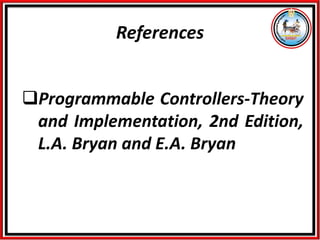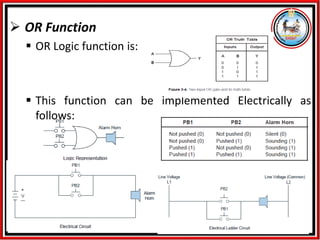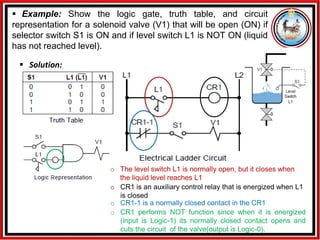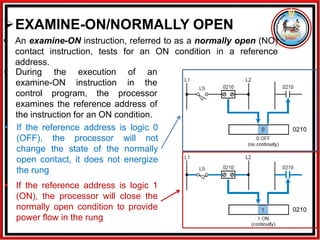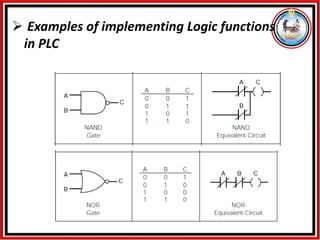Lecture_4-Logic_Functions_and_Symbols.pdf
- 1. Logic Functions and Symbols Dr. Amin Danial
- 2. References ❑Programmable Controllers-Theory and Implementation, 2nd Edition, L.A. Bryan and E.A. Bryan
- 3. ▪PLC’s were used in the industry to replace the replay control system. ▪Relay control systems used electrical circuits to implement the logic function in the control applications. ▪Consequently, relay controlled circuit are built in the PLC as a software program and even the programming language uses the symbols similar to the relay control circuits, which is called Ladder language. ▪The logic implemented in PLCs is based on the three basic logic functions AND, OR, and NOT Programmable Logic Controller
- 4. ➢ AND Function ▪ AND Logic function is: ▪ This function can be implemented Electrically as follows
- 5. ➢ OR Function ▪ OR Logic function is: ▪ This function can be implemented Electrically as follows:
- 6. ➢ NOT Function ▪ NOT Logic function is: ➢ Control Relay (CR) ▪ A Control Relay (CR) is an electromechanical device which has a coil that functions as an electrical magnet. When this coil is energized it pulls mechanical contacts to connect and disconnect electrical circuits.
- 7. ➢ Control Relay (CR) (continue) ▪ Normally Closed contact (NC): A contact is normally closed when it is in ON (closed) state when it is in inactivated condition. Consequently, it opens when it is activated. ▪ Normally Open contact (NO): A contact is normally open when it is in an OFF (open) state when it is in inactivated condition. Consequently, it closed when it is activated. NC NO
- 8. ▪ Solution: o The level switch L1 is normally open, but it closes when the liquid level reaches L1 o CR1 is an auxiliary control relay that is energized when L1 is closed o CR1-1 is a normally closed contact in the CR1 o CR1 performs NOT function since when it is energized (input is Logic-1) its normally closed contact opens and cuts the circuit of the valve(output is Logic-0). ▪ Example: Show the logic gate, truth table, and circuit representation for a solenoid valve (V1) that will be open (ON) if selector switch S1 is ON and if level switch L1 is NOT ON (liquid has not reached level).
- 9. ▪ Solution: Normally closed PB which performs NOT Function ▪ Example: Show the logic gate, truth table, and circuit representation for an alarm horn that will sound if push button PB1 is 1 (ON or depressed) and PB2 is NOT 0 (not depressed).
- 10. ➢ PLC Circuits NC Over Load Contacts NO auxiliary contact closes when the motor is ON Hardwired rung (network) PLC software implementation Output Field Devices Input Field Devices PLC Circuit Input Addresses Output Address ▪Each input point has an address which refers to a certain bit in the memory that stores the status of this input (1 or 0). ▪Each output point has an address that stores the program result that is reflected on the real field. If the stored value is 1 this point is activated and vice versa. ▪The PLC program reads the inputs from the input dedicated memory using the input addresses and writes the results in the output memory by pointing to it using output address. ▪ Each circuit that controls a certain individual output is called rung or network.
- 11. ▪ Example Limit Switch Pilot Light Input Field Devices Output Field Devices PLC software implementation Wiring to the I/O (Input-Output) Modules
- 12. ➢ Some Symbols used in PLC Programs ▪PLC programs are built in the form of virtual control circuit that resembles real electrical control circuits. Normally open contact. This is a virtual contact in the PLC program representing an input to the I/O module of the PLC. If the input is receiving a signal from the field (sensor or switch) this virtual contact closes and passes the signal to control circuit. Normally closed contact. This is a virtual contact in the PLC program representing an input to the I/O module of the PLC. If the input is not receiving a signal from the field (sensor or switch) this virtual contact is closed and passes the signal to control circuit. I case of Applying a signal to the input this contact opens and cuts the control circuit. Output. This is a coil of a virtual relay representing an output in I/O module of the PLC or an internal virtual output. This coil is energized or de-energized from the PLC program which is built in the form of virtual control circuit. When this coil is energized the corresponding point is energized. In addition virtual contacts of this virtual relay can be further used in the rest of the program.
- 13. ➢EXAMINE-ON/NORMALLY OPEN 0210 0210 ▪ An examine-ON instruction, referred to as a normally open (NO) contact instruction, tests for an ON condition in a reference address. ▪ During the execution of an examine-ON instruction in the control program, the processor examines the reference address of the instruction for an ON condition. ▪ If the reference address is logic 0 (OFF), the processor will not change the state of the normally open contact, it does not energize the rung ▪ If the reference address is logic 1 (ON), the processor will close the normally open condition to provide power flow in the rung
- 14. ➢EXAMINE-OFF/NORMALLY CLOSED 0210 0210 ▪ An examine-OFF instruction, also called a normally closed (NC) contact instruction, tests for an OFF condition in the reference address ▪ During the execution of an examine- OFF instruction, the processor examines the reference address for an OFF condition. ▪ If the reference address has a logic 0 status (OFF), the instruction will continue to provide power (continuity) through the normally closed contacts ▪ If the reference address has a logic 1 status (ON), the instruction will open the normally closed contact, thus breaking continuity to the rung ▪ An examine-OFF instruction can be associated with a logic NOT function, so that if the reference address is NOT ON, logic continuity will be provided.
- 15. 0310 0310 ➢ OUTPUT COIL ▪ An output coil instruction controls either a real output (connected to the PLC via output interfaces) or an internal output (control relay). ▪ During the execution of an output coil instruction, the processor evaluates all the input conditions in the ladder rung ▪ If no continuity exists, the processor places a 0 in the output coil address bit, indicating an OFF condition to the output coil instruction ▪ if the processor detects continuity in any path, the processor places a logic 1 in the output coil address bit referenced by the instruction. This logic 1 status indicates an ON condition to the output coil instruction.
- 16. ➢ Examples of implementing Logic functions in PLC
- 17. ➢ Examples of implementing Logic functions in PLC
- 18. Thanks

